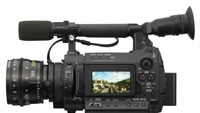Sony aims to reclaim acquisition status

The age-old cautionary tale of awakening a sleeping giant might be appropriate when looking at Sony’s new products showing at this years’ NAB Show. For the past three years, Sony has basically sat by, at times seemingly unable to recognize a growing ground swell of change, as a number of suppliers developed next-generation professional cameras that slowly ate away at its key market segments of independent filmmakers, local ENG and high-end TV production.
This year Sony has emerged from its slumber with new models based on CMOS sensor technology developed in house at its Atsugi facility in Japan that show promise for those professionals seeking images with a shallow depth of field or the highest-resolution image capture possible to emulate the look of film. Sony said it has been able to eliminate the moiré and aliasing problems experienced with many current HDSLRs while reducing the rolling shutter effect of CMOS imagers. In addition, when compared to traditional CCD chips, which Sony continues to offer in some existing models, CMOS offers increased resolution, lower power consumption, minimized noise artifacts and virtually zero image smearing. Local news crews could also benefit from Sony’s new emphasis on customer requirements.
Thanks to a companywide dedication to CMOS across dozens of its products, both consumer and professional, over the last few years, Sony has improved manufacturing processes and developed new pixel-packing and coding techniques that have resulted in better signal-processing performance and a higher density (pixel count) across its 1/3in, 1/2in, 2/3in and 35mm CMOS Exmor chip lines.
That the 2011 NAB Show in Las Vegas, Sony will show new HD models in its NXCAM, XDCAM and CineAlta product families.
“We have reached the point where we are able to use our wealth of engineering expertise to answer customers’ desires for the next-generation of products that can do more,” said Shoji Nemoto, co-president of Sony’s Professional Solutions Group. “I think for the past two years, we have been trying to understand the market segments better. And at NAB, you will see the result of this better understanding.”
The theme for Sony NAB exhibit this year is “Beyond HD,” signaling the company’s newfound recognition that 1080- and 720-line HD acquisition has become the norm and its customers want more.
Sony will show a new NXCAM camera that addresses the needs of those gravitating toward digital SLR cameras that offer shallow depth of field and high resolutions, beginning at 1080p/60. This camera also features two-channel audio capture, something not found in current model DSLRs.
The professional video industry's #1 source for news, trends and product and tech information. Sign up below.
While some other companies have shown cameras capable of acquiring image data at 4K, Sony has developed an 8K x 2K, 21.4-megapixels Super35 CMOS sensor camera as part of its CineAlta HDCAM SR line that acquires 4K as 16-bit raw data, but, according to the company, it is capable of so much more. Its 18:8:8 sensor, twice the density of a 4K Bayer sensor, can record a wide color space to solid-state memory at 24fps. The company will also show tools to efficiently handle this high-resolution data, in the form of projectors, monitors and solid-state memory cards of up to 1TB of capacity.
Leveraging this new Exmor sensor technology has also resulted in the introduction of two new camcorders: the PMW-F3, which includes the ability to shoot in HD or Sony’s S-Log gamma setting, and a new shoulder-mount 3-D camcorder that includes dual 3CMOS 1/2in sensors (six total) and dual presynchronized lenses, 45mm apart, to capture right- and left-eye images and then converge them inside the camera. Both of these models, designed for documentary producers and broadcast news professionals, are an extension of Sony’s XDCAM EX line.
There’s also a smaller NXCAM 3-D model that features a 3.5in autostereoscopic LCD viewfinder panel. It also offers frame packing or side-by-side output via and HDMI connection.
Speaking of the XDCAM line, which has sold 180,000 units worldwide thus far, Sony will introduce new capacities on dual- and quad-layer discs (up to 128GB) and demonstrate a new jukebox for nearline storage of footage stored on the system’s optical discs, as well as XDCAM Archive software to manage larger libraries. The later can serve as the ingest point for an archive that can manage full-resolution (800 hours at 50Mb/s) or lower-resolution proxy files (85,000 hours at 500kb/s). This archiving software, developed in China, also provides the ability to perform multiple channels of ISO recording and can be used as an instantly available clip store during live productions.
Broadcasters yet to make the transition from SD to HD might also be interested in a new SD/HD camera that features three 2/3in HD CMOS sensors and a single multicore (coax) cable attached to an external CCU to convert HD signals to SD. It can also be used as a wireless camera with widely available third-party recorders.
The NXCAM line will offer two new models this year: one compact model that is hermetically sealed to withstand the often-problematic effects of moisture and dust and the other directed toward DSLR users, which uses the same Super35mm CMOS sensor as the PMW-F3 and offers the ability to change lenses.
“The goal with our newly designed CMOS technology is to expand the scope of human vision on the screen,” said Peter Crithary, marketing manager for Sony’s production products in the United States. “We’re not just talking about more brightness and wider color space; we’re actually delivering it.”
See Sony at the 2011 NAB Show in Booth C11001.
